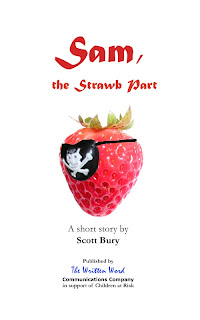A hearty Book Blather welcome to a neighbor to the north. Scott Bury is a journalist, editor and writer living in Ottawa. His articles have been published in newspapers and magazines in Canada, the US, UK and Australia, including Macworld, the Ottawa Citizen, the Financial Post, Marketing, Canadian Printer, Applied Arts, PEM, Workplace, Advanced Manufacturing and others.
He has two almost-grown children, an orange cat and a loving wife who puts up with a lot. You can read more of Scott’s writing at scottswrittenwords.blogspot.com and scottstravelblog.wordpress.com, and on his website, http://www.writtenwords.ca. Follow him on Twitter @ScottTheWriter.
“Electronic publishing” is a term that’s been used for decades now, but its meaning, or what we categorize under that heading, has changed.
In 1986, I started writing and editing at a new magazine called Electronic Publishing. To tell the truth, that name was a bit of a cheat: we were trying to sound a little more professional than “desktop publishing,” and both terms really did not mean “publishing” at all. They referred to the new desktop computer programs that laid out pages. Eventually, the results of the work done on PCs would be printed on paper.
The most remarkable thing about the desktop publishing boom of the late 80s was the speed of its development. Tasks that were impossible in 1986 were routine just two or three years later. At the beginning of the curve, the biggest challenges were keeping track of your fonts and making sure that pages would print out in the right order. Within a few years, we had automated pagination and were struggling with getting the computer monitors to match the colour from an offset printing press.
Today, electronic publishing is more about actually publishing—that is, getting the content out to as the public to read on an electronic reader. No paper need get involved. That industry is going through a similar learning curve now.
Independent authors and publishers are struggling to learn the tools that format text files for clear, readable display on a Kindle, Kobo or tablet computer. Just as in the 1980s, we are working with fairly blunt tools. Formatting is almost completely in the hands of the reader or the e-reader. We cannot choose the typeface, colour is impossible and incorporating images within the text requires special software.
When it comes to information, I believe “more is more.” As an author, I would like to be able to choose the typeface, and to use colour. I prefer different headers and footers for left and right pages, and for the first pages of chapters—not just to be fancy, but to carry different information. I would prefer the author’s name to appear on one side, and the book title on the other; it would also be nice to have the current chapter title. While these aren’t necessary, they add to the information available to the reader. Unfortunately, the current EPUB and MOBI formats—the most common today—and the software that creates those files, do not deliver that level of control.
Anyone who has used Smashwords’ “meat grinder” to produce the EPUB format book knows that you cannot use the Page Break code. This means that, often, your copyright information appears on the same “page” or screen as the opening of your book.
Would it be so hard for the meatgrinder to recognize page breaks? Or at least, to tell us authors how to code them?
Everything about your book communicates: not just the content, but also the page layout, the header and footer information, the type font, and the colour. They all have impact on the reader’s experience with the text. We don’t have to use these tools; we can choose allow the book to appear in default settings—but I would prefer to have the choice.
I know that these are early days and the tools are being developed even as I write these words. Within two years, we independent e-publishers will have a lot more control over the format of our books.
I can’t wait.
Look for Scott's work at: Amazon: http://www.amazon.com/Sam-the-Strawb-Part-ebook/dp/B005NFHASM/ and Smashwords: http://www.smashwords.com/books/view/89276
Look for Scott's work at: Amazon: http://www.amazon.com/Sam-the-Strawb-Part-ebook/dp/B005NFHASM/ and Smashwords: http://www.smashwords.com/books/view/89276



Nice post Scott! It's hard enough to write, self-publish and market a book, so hopefully once the publishing piece is more streamlined, it will be one less thing to worry about!
ReplyDeletePosted by Marilee but comment is from Diane via LinkedIn:
ReplyDeleteGood info. I have not tried the e-pub route though I have been contemplating it for one or two of my books. I'm technologically challenged in many ways though I have set up a few web sites with some success. But I'm just not sure about formatting for e-books. I suppose one day I'll have to take the bull by the horns and just do it. Thanks for the post.
Diane
It's true - the technical side of publishing is the easy part. In fact, I knew how to get a book physically printed long ago, and in one of my earlier jobs, I got to know a lot of the major and smaller printers in Canada, as well as the typesetters (until they vanished at the outset of desktop publishing) and bookbinders.
ReplyDeleteThe bigger challenge has always been selling the books. Making books is a science or a craft, an industry; making people read them is an art, or maybe magic.
Scott, this comment if from Jean Denham who sent it to me:
ReplyDelete"Although I’m too old fashioned to use anything but a ‘hard copy’ of a recipe while I’m cooking, I’d love to break into the world of electronic publishing to offer my cookbooks to those who have their kindles, etc. as an attachment to their arms. As Diane said, “maybe one day……”
Thanks for an interesting article, Scott."
Jean Denham